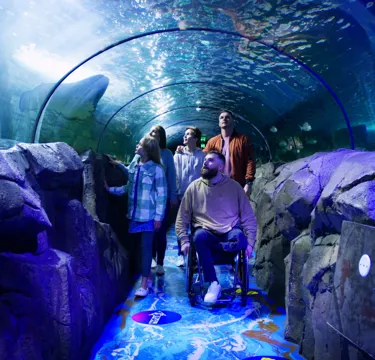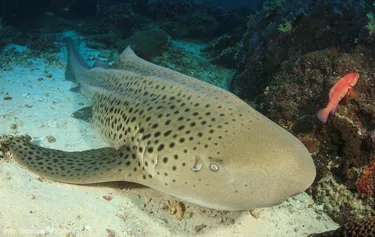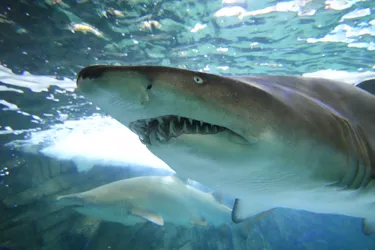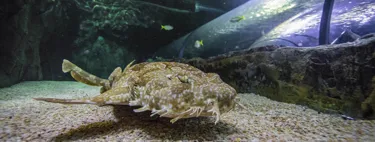Meet the Sharks at SEA LIFE Sydney!
- Wednesday 23rd July 2025
- Brittany Jazevski
- Sharks, Sea Life

Discover the legends of the deep at SEA LIFE Sydney Aquarium! Home to 13 incredible shark species, this is your chance to come face-to-fin with Grey Nurse Sharks, Wobbegongs, Port Jacksons and more.
Take your adventure to the next level with Shark Dive Xtreme – a thrilling cage-free dive with real sharks (no diving experience needed).
What is a Shark?
Sharks aren’t just one type of animal, they’re an entire subclass of fish that have been evolving for hundreds of millions of years. They’re fast, efficient, and built for survival in nearly every corner of the ocean.
Instead of bones, sharks have flexible skeletons made of cartilage (like what your ears are made of), and they belong to a group called elasmobranchs, which also includes rays and skates. Some species are small enough to fit in your hand, others stretch longer than a bus. That’s some serious variety.
How long have sharks been around?
Shark-like creatures have existed for over 400 million years, making them one of the oldest surviving groups of vertebrates on the planet. That means they were here long before dinosaurs, and they’ve survived five mass extinction events since.
These early ancestors didn’t look exactly like the sharks we know today. Some lacked teeth entirely, while others had bony plates or rough, tooth-like scales. Over time, true sharks evolved the features we recognise now: streamlined bodies, regenerating teeth, and cartilaginous skeletons that help them glide effortlessly through the water.
Their ability to adapt again and again is exactly why they’re still here, and why they’re such an important part of our oceans today.
💡Did you know? The earliest known shark-like fossil, Elegestolepis, dates back over 420 million years, but scientists are still debating whether it was a true shark or a close relative.
Are sharks fish?
Yes, though they’re not your average fish by any stretch. Sharks are cartilaginous fish, meaning their skeletons are made of cartilage instead of bone. This makes them lighter and more flexible than bony fish. They belong to a group called elasmobranchs, which also includes rays and skates.
Cartilage might sound flimsy, but it’s actually a clever trade-off - it helps sharks stay buoyant and agile, especially when paired with their massive, oil-rich livers.
💡Did you know? The whale shark is the largest fish in the world, growing up to 12 metres long!
Wait, what? Yes, whale sharks are sharks - not whales. Sharks are fish. Whales are mammals. Whale sharks are fish. Confusing? A little. Cool? Absolutely.
How many species of sharks are there?
There are over 500 known species of sharks around the world, ranging from hand-sized deep-sea dwellers to the 12-metre-long whale shark, the world’s largest fish. Australia alone is home to around 170 to 180 species, making it a global shark hotspot.
And that’s just species, many sharks also have subspecies or regional variants that look alike but behave differently, adding even more depth to the shark family tree.
At SEA LIFE Sydney Aquarium, you’ll find 13 unique shark species, including the Grey Nurse Shark, Blacktip Reef Shark, Epaulette Shark, and the oddly adorable Wobbegong, giving you a close-up look at just how varied sharks can be.
- Tawny Nurse Shark
- Leopard (Zebra) Shark
- Epaulette Shark
- Wobbegong Shark (Spotted Wobbegong)
- Blacktip Reef Shark
- Grey Nurse Shark

How do sharks survive and thrive in the ocean?
Sharks have evolved a range of specialised adaptations that make them some of the ocean’s most successful predators. From their skeletons to their senses, everything about them is built for efficiency, stealth, and survival.
How do sharks breathe and stay afloat?
Sharks breathe through five to seven gill slits on the sides of their heads, pulling oxygen from the water as it flows over their gills. But unlike most bony fish, many sharks don’t have a swim bladder to help with buoyancy.
Instead, they rely on a massive oil-rich liver (which can make up 25% of their body weight) to help them stay afloat. Many species also need to keep swimming to push water over their gills, this is called ram ventilation. However, some sharks can actively pump water through their gills and rest on the seafloor.
💡 A shark’s liver is so oily it helps them stay buoyant - it’s basically their natural floatation device.
What senses do sharks have?
Sharks have an incredibly refined set of senses that help them hunt and navigate in challenging environments:
-
Smell: Sharks can detect tiny concentrations of chemicals in the water, sometimes parts per billion.
-
Hearing: They can pick up low-frequency sounds and vibrations from far away.
-
Vision: Many sharks see well in low light, and while most don’t see in full colour, they can detect contrast extremely well.
-
Lateral line: This detects movement and pressure changes around them, great for tracking nearby prey.
-
Electroreception: Unique to sharks and rays, ampullae of Lorenzini are tiny pores on their snout that detect the electric fields given off by living creatures, even ones buried in sand.
💡Sharks can sense a fish’s heartbeat - even if it’s hiding under the seabed.

How do sharks move through the water?
Sharks are incredibly streamlined. Their skin is covered in dermal denticles, tiny tooth-like scales that reduce drag and let them glide smoothly through water. Their tails (caudal fins) come in a variety of shapes depending on their lifestyle:
Crescent-shaped caudal fin (lunate) - Built for speed in open water, like the Shortfin Mako.
Asymmetrical caudal fin (heterocercal) - Seen on most sharks, including the Great White, it helps them stay afloat without a swim bladder.
Rounded caudal fin (subterminal) - Suits bottom-dwellers like the Wobbegong, allowing quick turns and bursts in tight spaces.
Whip-like upper lobe (elongated heterocercal) - Unique to the Thresher Shark, this dramatic tail stuns prey with powerful overhead slaps.
Their pectoral fins provide lift, much like an airplane’s wings, and their overall body shape is designed to conserve energy while moving, ideal for long-distance travel or ambush hunting.
💡Some shark skin is so hydrodynamic it's inspired swimsuits, aircraft coatings, and even antibacterial surfaces.
How many teeth does a shark have?
Sharks don’t just have one row of teeth — they have multiple rows, and some species cycle through tens of thousands of teeth in a lifetime. On average, a shark may have 50 to 300 teeth visible at a time, but that’s just the tip of the iceberg. Behind the front row are several backup rows, waiting to move forward like a conveyor belt when a tooth is lost.
This system of constant regeneration is what makes shark teeth so fascinating. Unlike humans, who only get two sets of teeth in a lifetime, sharks can replace a lost tooth in just a few days. Some species shed over 30,000 teeth in their lives — that’s a lot of dental turnover.
Do sharks sleep?
Sort of, but not like we do. Sharks don’t have eyelids to close or a need to lie down, but many go into restful, low-energy states. Some species can rest motionless while still pumping water over their gills, while others enter a cruise-control-like mode where they keep swimming but their brain activity drops.
Shark sleep patterns vary widely. Bottom-dwelling species like nurse sharks can rest on the sea floor and actively breathe through buccal pumping, while open-ocean swimmers like great whites need to keep moving to stay oxygenated.
Researchers are still uncovering how sharks rest, some believe their version of sleep may be much more complex than we thought.
💡Some sharks have periods of rest with one part of their brain less active - a bit like dolphins.
Are sharks intelligent?
Yes, and it goes beyond instinct. Studies show that sharks can learn, remember, and even solve problems. Some can navigate complex environments, recognise visual patterns, and remember areas where they’ve found food in the past.
Their intelligence varies by species, but many sharks exhibit strategic behaviours when hunting, such as using ocean currents or terrain to trap prey. Combined with unique personalities and social quirks, sharks are far from the mindless predators they're often made out to be.
Reef sharks have been observed returning to specific locations year after year - a sign of impressive spatial memory.
💡Shark sidekicks? You’ll sometimes spot smaller fish swimming right alongside sharks. These are usually remoras, also known as suckerfish. They use a suction disc on their head to hitch a ride and feed on leftovers. It’s a free meal, free travel, and (mostly) safe spot all in one.
Do sharks have personalities?
Surprisingly, yes. Studies show that sharks can have distinct personalities, even within the same species. Some individuals are bold and curious, swimming straight up to divers or exploring unfamiliar areas, while others are shy or prefer to be alone. Others are more cautious or solitary. These personality traits can affect how they explore, hunt, and even interact with other sharks.
These traits are thought to be shaped by both genetics and experience, much like in other animals. And while sharks don’t form social bonds like dolphins, some species display social behaviours, resting in groups, hunting cooperatively, or swimming alongside familiar companions.
🍋 Lemon sharks have even been observed forming “friendships” - regularly returning to swim with the same individuals!
💡Scientists studying sharks have found consistent behavioural traits like boldness, sociability, and shyness - not too different from your average pet.
Are sharks the apex predator of the ocean?
It's a common belief, and technically, yes, great white sharks are the apex predators among fish.
But in the whole ocean, that top spot belongs to the orca (killer whale) - the ultimate apex predator across seas.
In recent years, scientists have observed orcas actively hunting great whites using coordinated tactics - even flipping them over to induce tonic immobility and extract their livers with near surgical precision. These discoveries, backed by tagging data and drone footage, have reshaped our understanding of the food chain. While sharks remain formidable, orcas have proven they’re the true rulers of the ocean.
Pretty wild, right? You’ll learn more about how they manage that in the next section.
Do sharks have weaknesses?
For all their power, sharks aren’t invincible. In fact, they have a few surprising vulnerabilities — some behavioural, some biological that most people don’t expect.
One of the strangest is a reflex called tonic immobility. When certain sharks are flipped upside down or lightly touched on their snout, they enter a trance-like state. Their muscles go limp, they stop responding to stimuli, and they appear temporarily paralysed. Scientists still aren’t entirely sure why this happens, though it’s often triggered during mating or used by researchers during handling.
In rare cases, predators like orcas have been observed exploiting this reflex to their advantage.
Sharks also face other design limits:
-
Low reproduction rates: Many sharks take years to mature and produce only a few offspring at a time. That makes them highly vulnerable to overfishing, since populations recover slowly.
-
Dependence on constant movement: Some species (like great whites) need to keep swimming to breathe, which means they can’t rest in place like other fish. If trapped or caught, they can quickly suffocate.
-
No swim bladder: Sharks rely on their oil-rich liver and movement to stay buoyant. If they’re injured or lose motion, they can sink and struggle to stay afloat.
💡Shark tonic immobility is so reliable that scientists often use it during medical checkups, like an oceanic “pause” button.
How do sharks reproduce?
Shark reproduction is anything but ordinary. Unlike most fish that spawn thousands of eggs into open water, sharks invest more time and energy into fewer, more developed offspring, and how they do it varies widely between species.
Do sharks lay eggs or give birth to live young?
Some sharks lay eggs. Others give birth to live pups. And some do a bit of both.
In November 2024, we proudly witnessed the world-first birth of a Grey Nurse Shark pup at our facility, marking a significant milestone for endangered shark recovery efforts

There are three main reproductive strategies in sharks:
-
Oviparous (egg-laying): The female lays tough, leathery egg cases often called “mermaid’s purses”. These are left to develop on the seafloor. Common in bottom-dwelling species like catsharks and some carpet sharks.
-
Viviparous (live-bearing with placenta): Similar to mammals, the embryo grows inside the mother and is nourished by a placenta. Found in some larger species like reef sharks.
-
Ovoviviparous (eggs hatch inside the mother): The eggs develop internally, and the young are born alive, but without a placenta. Instead, they feed on the egg yolk or, in some species, other embryos.
Some shark pups hatch inside the mother and then eat their unhatched siblings, a behaviour called intrauterine cannibalism. In species like the sand tiger shark, embryos develop in two separate uteruses, and the first one to hatch in each womb eats the rest of the eggs and embryos around it.
The shark lifecycle
From the moment they're born (or hatched), sharks are on their own — no parental care, just instinct and a vast ocean to navigate. Their journey to adulthood is long, and survival is anything but guaranteed.
Pup
Depending on the species, shark pups are either born live or hatch from egg cases on the seafloor. They emerge fully formed and start hunting straight away. Some head into open water, while others stick to nursery zones for safety.
Juvenile
Young sharks grow slowly and remain vulnerable to predators — even other sharks. Many stay in sheltered areas until they're large enough to defend themselves. It can take 5 to 15 years for most species to mature.
Adult
Mature sharks begin to reproduce, often migrating long distances to reach breeding grounds. Some species reproduce annually, while others do so far less frequently.
Lifespan
Shark lifespans vary. Some live 20 years, others, like the Greenland shark, can survive for centuries. But most grow slowly and reproduce rarely, making them vulnerable to overfishing and environmental change.
💡The Greenland shark is believed to be the longest-living vertebrate on Earth, with one individual estimated at over 400 years old.
How many pups do sharks have?
It depends on the species. Some sharks give birth to just one or two pups at a time. Others can have dozens or even hundreds, though that’s rare.
Even in the best-case scenario, sharks tend to have fewer offspring, less frequently, and mature much later in life compared to other fish. Some species take over a decade to reach reproductive age. This makes it hard for populations to bounce back from overfishing or environmental pressures.
💡 Blue sharks hold the record for the biggest litter - with up to 135 pups in one go!
Do sharks have mating rituals?
Shark mating is rarely observed in the wild, but what researchers have seen suggests it’s brief, physical, and highly instinctual. Males often grasp the female using their mouths, which is why females in some species have evolved thicker skin or skin folds in key areas as a natural form of protection.
Most sharks are solitary animals and usually only come together to mate. Once the encounter is over, they typically part ways. Some species may form loose seasonal groupings, but long-term social bonds after mating are uncommon.
Many shark species have never been seen mating in the wild, most of what we know comes from aquariums and lucky camera footage.
How long is shark pregnancy?
Shark gestation varies widely by species. Some carry their young for a few months, others for over two years, making it one of the longest pregnancies of any vertebrate. This slow and energy-intensive process is one reason sharks reproduce infrequently, and why many species struggle to recover from population decline.
Can sharks reproduce without males?
Yes, some female sharks are capable of parthenogenesis, a form of asexual reproduction where an embryo develops without fertilisation. Instead of sperm, a spare cell from the mother’s own body (called a polar body) fuses with her egg to kickstart development.
The result is a pup that shares almost identical DNA with the mother, like a biological copy, but with less genetic diversity.
It’s rare, and usually only seen in certain species. Scientists don’t fully understand all the triggers yet, but it’s one of the more mind-blowing shark adaptations.
Parthenogenesis is most often seen in sharks living in captivity or isolation, where no males are present. Scientists believe it may be an evolutionary safeguard - a way to ensure reproduction can still occur when mating opportunities are limited
What role do sharks play in marine ecosystems?
Sharks are keystone species, animals that have a disproportionately large impact on the health and stability of their ecosystems. As top and mid-level predators, they help regulate the balance of marine food webs, control populations of prey species, and influence the behaviour of other animals across the reef, open ocean, and seafloor.
When sharks are present and thriving, marine ecosystems function better: biodiversity stays high, habitats are protected, and prey populations remain in check. When sharks decline or disappear, the effects ripple outward, often leading to ecosystem collapse.

How do sharks help control the food web?
Many shark species sit near the top of their food chains, playing a crucial role in regulating the populations of fish, rays, and other marine animals. By keeping prey species in check, they help prevent imbalances that could damage coral reefs, seagrass beds, and fish communities.
Even mid-level sharks contribute by shaping how and where prey move, a concept known as the “landscape of fear.” Their presence influences the behaviour of other animals, which helps protect vital habitats from overgrazing or overuse.
Sharks are not the only piece of the puzzle, but without them, the entire ocean system begins to weaken.
Their role may not always be visible, but it's essential. Healthy oceans need healthy shark populations. And when the ocean suffers, so do we, through lost biodiversity, damaged fisheries, and a planet less equipped to regulate climate and support life.
Did you know? The ocean produces 50% to 80% of the oxygen we breathe, thanks to phytoplankton, tiny plant-like organisms that live in the water. While much of that oxygen is used by marine life, the rest helps sustain life on Earth. These microscopic powerhouses depend on healthy ecosystems, which is why protecting sharks and other marine species matters more than you might think.
Why do sharks need protecting?
Shark populations around the world are in serious decline, not because of natural predators, but because of us. Overfishing, shark finning, accidental bycatch, and habitat destruction have pushed many species to the brink. Combine that with the fact that sharks reproduce slowly, and it’s easy to see how we got here.
This isn’t a distant issue. In just the past few decades, the number of oceanic sharks and rays has dropped by more than 70%. Some species have declined by over 90%, and nearly one-third of all known sharks are now threatened with extinction.
And that’s a problem - not just for sharks, but for the ocean as a whole. As we’ve seen, sharks play an essential role in maintaining the balance of marine ecosystems. If they disappear, those ecosystems begin to unravel. And if the ocean collapses, the ripple effects could touch every part of life on Earth, from food systems to climate regulation to oxygen production.
We got here through centuries of fear, misunderstanding, and short-term thinking. But now we know better. And we have a chance to do better.
Every year, it's estimated that 80 million sharks are killed by fishing — and up to 100 million when accounting for unreported and bycatch figures.
(This remains the most widely accepted range among researchers, and sadly, the trend shows no signs of decline despite conservation efforts.)
A global study published in Nature found that the abundance of oceanic sharks and rays has declined by 71% since 1970, largely due to overfishing. In fact, three-quarters of these species are now threatened with extinction, making it one of the clearest signs of marine ecosystem distress in the modern era
Why are so many sharks killed?
The biggest driver is the global demand for shark fins, used in shark fin soup, a dish considered a delicacy in some cultures. In many cases, sharks are caught, their fins are removed, and the rest is discarded. Others are killed for meat, cartilage, liver oil, or caught accidentally as bycatch in large-scale fishing operations.
There is hope
In 2022, world leaders committed to protecting 30% of the world’s oceans by 2030, a global promise to reverse damage, preserve biodiversity, and give marine ecosystems the breathing room they desperately need. If this commitment is fulfilled, it could be the most significant ocean conservation effort in history.
But promises aren’t enough on their own. We need education. We need action. And we need global collaboration to ensure that sharks, and the ecosystems they support, not only survive, but recover.
Our commitment to shark conservation
At SEA LIFE Sydney Aquarium, we don’t just display sharks, we take action.
-
Our dedicated Animal Rescue Centre operates 24/7 with NSW Fisheries permits to rescue, rehabilitate, and release injured or entangled Grey Nurse Sharks and other marine species.
-
We are a key partner in the Zebra Shark StAR Project, breeding and supplying eggs for re-wilding programs aimed at restoring wild populations in the Indo-West Pacific.
-
Our team collaborates with university and government researchers in tagging, behavioural studies, and habitat protection initiatives, strengthening scientific understanding and conservation outcomes.

Plan Your Visit
Ready to meet the legends of the deep?
Come face-to-fin with Grey Nurse Sharks, Wobbegongs, Blacktip Reef Sharks and more at SEA LIFE Sydney Aquarium, or take the plunge with Shark Dive Xtreme for a cage-free encounter you'll never forget.
Book NowShark FAQs at SEA LIFE Sydney
We’re home to 13 incredible shark species, from the iconic Grey Nurse Shark to Wobbegongs, Blacktip Reef Sharks, and more. You’ll even find some baby sharks in our nursery zone!
Shark Valley is our stunning walk-through oceanarium. It’s where you can see sharks swimming all around you, and sometimes right overhead, in one of the deepest indoor exhibits in the world.
Yes! Shark Dive Xtreme is one of the only cage-less shark dives in the world where no scuba experience is needed. You’ll come face-to-fin with Grey Nurse Sharks in an experience you’ll never forget.
Despite their reputation, our sharks are calm, curious, and incredibly misunderstood. The species at SEA LIFE Sydney are not a danger to guests and are cared for by expert aquarists.
We actively support shark conservation through rescue and rehab work, breeding endangered species like the grey nurse shark, and contributing to global rewilding efforts. Learn more in our conservation section above.
Yes! Our aquarists feed the sharks regularly, and visitors can often watch during scheduled feeding sessions. Check the daily program for timings and be sure to catch a keeper talk.
Absolutely. Shark Valley is a gentle, accessible walk-through experience perfect for all ages, and a favourite for little ones with big imaginations.
Please note, ramps can sometimes be too steep for wheelchair users if they do not have anyone with them to provide assistance.
They do! Like cats and dogs, individual sharks can show different temperaments. Some are shy, some bold, and others just curious about their environment.